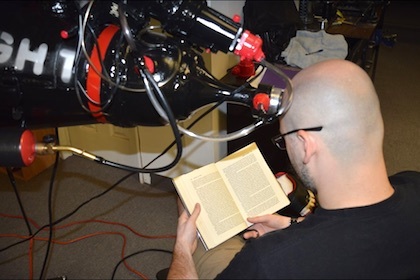Marc Abrahams's Blog, page 252
September 10, 2016
New 5-second-rule study overlooks earlier work on dropped food (especially toast)
A new study about whether it’s safe to eat dropped food — specifically watermelon, gummy bears, and buttered toast — neglects to mention the two Ig Nobel Prizes that figure into its doings. The new study is:
 “Longer Contact Times Increase Cross-Contamination of Enterobacter aerogenes from Surfaces to Food — Is the five-second rule real?,” by Robyn C. Miranda and Donald W. Schaffner [pictured here], Applied and Environmental Microbiology, epub 2016.
“Longer Contact Times Increase Cross-Contamination of Enterobacter aerogenes from Surfaces to Food — Is the five-second rule real?,” by Robyn C. Miranda and Donald W. Schaffner [pictured here], Applied and Environmental Microbiology, epub 2016.
The 2004 Ig Nobel Prize for Biology was awarded to Jillian Clark (who at the time was a high school student) for investigating the scientific validity of the Five-Second Rule about whether it’s safe to eat food that’s been dropped on the floor. Clark found that, with a clean floor, the amount of bacteria transferred from floor to food depends on how sticky or wet that food is.
The 1996 Ig Nobel Prize for physics was awarded to Robert Matthews of Aston University, England, for his studies of Murphy’s Law, and especially for demonstrating that toast often falls on the buttered side.
The new study mentions neither of these. Either egregiously or — alternatively, just confusingly — the paper does not specify whether its own buttered toast landed on the buttered side. The authors, based at Rutgers University, say they did separately test butterless bread, but do not say whether their buttered bread was buttered on one side or two.
(Thanks to Neil Judell for bringing the new study to our attention.)

September 8, 2016
Scientists with action-hero names: Hudson Freeze

hudson_freeze_profile.JPG
Another scientist with an action-hero name is Hudson Freeze, Ph.D. Or, phrased alternatively: Hudson Freeze, Ph.D, is another scientist with an action-hero name.
Dr. Freeze says (on his website, and presumably elsewhere):
“Getting a cure is pretty difficult, but it starts from doing research. It starts from understanding the basic processes, the scientific processes, the physiological processes. So what we try to do is to uncover enough basic science that we gain insights into how the human body…works.”
(Thanks to Ivan Oransky for bringing this to our attention.)

Slime moulds and French motorway planning (new study)
Toshiyuki Nakagaki, Atsushi Tero, Seiji Takagi, Tetsu Saigusa, Kentaro Ito, Kenji Yumiki, Ryo Kobayashi of Japan, and Dan Bebber, Mark Fricker of the UK, were jointly awarded the 2010 Ig Nobel Transportation Planning prize for using slime mould to determine the optimal routes for railroad tracks. See: ‘Rules for Biologically Inspired Adaptive Network Design’ in Science, Vol. 327. no. 5964, January 22, 2010, pp. 439-42.
If slime moulds can help plan the Tokyo rail network, might they also successfully apply their ’embodied intelligence’ to rationalise motorway network topology? Specifically French motorway network topology? This is the question asked – and answered – in a new research study scheduled for publication in the journal Environment and Planning B Planning and Design entitled: ‘Evaluation of French motorway network in relation to slime mould transport networks’ The photos below show slime mould explorations (in Petri dishes) where oat flakes are used to represent the major French urban centres.
“We demonstrate that despite the apparent complexity of the challenge, Physarum can successfully apply its embodied intelligence to rationalise the motorway topology. We also demonstrate that such calculations prove challenging in the face of significant obstacles such as, mountainous terrain and may account for the missing route between Nice, Grenoble, Avignon and Lyon.”
The team also note possibilities for future research work, using spiders instead of mould:
“For a further study, it would be interesting to experiment whether a spider would construct a similar network structure given the same boundary constraints as topographically delineated at the French frontiers.”
Note: The new paper doesn’t cite the recent work by Dimonte, Adamatzky, Erokhin and Levin who found that : ‘Slime moulds prefer right turns’
UPDATE (September 8, 2016): They also do it in 3D, Reto Schneider reports.

September 7, 2016
Yoga-with-goats research opportunity
A rare opportunity presents itself to conduct research on yoga with goats.
The No Regrets Farm, in Oregon, is conducting sessions of yoga with goats. Researchers interested in pursuing this are advised to get in touch with the farm’s director.
Opportunities exist elsewhere, too. This video could be the basis for an entire PhD thesis:

Podcast 80: “The Best Life — Act 1 (of 3)” — A scientific mini-opera where everything goes wrong.
Act 1 of the 3-act mini-opera “The Best Life”, about about a competition to choose the best species of life — that’s this week’s Improbable Research podcast.
SUBSCRIBE on Play.it, iTunes, or Spotify to get a new episode every week, free.
This week, Marc Abrahams introduces Act 1 of the mini-opera “The Best Life,” which premiered as part of the 2015 Ig Nobel Prize Ceremony, at Harvard’s Sanders Theatre. This is a recording from that performance:
The plot of Act 1: [As you’ll hear the narrator, Karen Hopkin, explain:] It’s the day before The Greatest Competition Ever Held — a competition to choose which ONE of the millions of species of life is… THE BEST LIFE. The competition will be televised live, everywhere — and the public is going nuts, eager to pay huge prices to watch it live. All the species of life — every single species, millions of them! — are going to be together, IN ONE ROOM, for the competition. There has never, ever been such a gathering, except maybe in a biblical sense, if you want to savor that story ark. Let’s watch the two organizers — giddy with nervous excitement, as they do last-minute preparation. If you listen closely, you might also hear the choral voices of seven billion humans, expressing their anticipation at the imminent television event of the century.
The libretto: The entire libretto is included in IgBill, the printed program that was handed out to all 1100 people who attended that performance. You can download your own copy of IgBill, and read along as you hear the singers sing and the instrumentalists do whatever it is they are doing.
The creators/producers: The music is by Giuseppe Verdi and Arthur Sullivan, the story and words by Marc Abrahams. The performance was directed by Maria Ferrante, assisted by Robin Abrahams, and costumed by Catherine Quick Spingler.
The performers: starring Maria Ferrante, Scott Taylor, and Daniel Rosenberg,
with The All-Species Chorus — Delphine Gabbay (chorus wrangler), Erika Hutchinson, Sylvia Rosenberg, Julia Lunetta, Vicki Bloom, Ros (Rosalind) Reid, Natasha Rosenberg, Abby Schiff, Vijaya Sundaram, Rob Hart, Liz Oppenheim, Warren Senders, Ted Sharpe, Nick Carstoiu, et al. The chorus ranks were swelled, in Act 3 of the opera, by addition of Nobel laureates Dudley Herschbach (chemistry, 1986), Carol Greider (physiology or medicine, 2009), Frank Wilczek (physics, 2004), Jack Szostak (physiology or medicine, 2009), and Eric Maskin (economics, 2007). The singers were backed by the Concentrated Forces of Nature, a distilled orchestra composed entirely of Harvard Medical School researchers Patrick Yacono and Dr. Thomas Michel.
Libretto plus: The libretto also appears, with photos from opera and juicy details from the entire the Ig Nobel ceremony, in the special 2015 Ig Nobel issue of our magazine, the Annals of Improbable Research. Here’s a photo (by ace photographer David Holzman) from Act 1:

The mysterious John Schedler or the shadowy Bruce Petschek perhaps did the sound engineering this week.
The Improbable Research podcast is all about research that makes people LAUGH, then THINK — real research, about anything and everything, from everywhere —research that may be good or bad, important or trivial, valuable or worthless. CBS distributes it, on the CBS Play.it web site, and on iTunes and Spotify).

September 6, 2016
The bottomless soup bowl experiment, described by its inventor
 Brian Wansink talks, in this video, about the Bottomless Soup Bowl Experiment, and how that won him the 2007 Ig Nobel prize for nutrition.
Brian Wansink talks, in this video, about the Bottomless Soup Bowl Experiment, and how that won him the 2007 Ig Nobel prize for nutrition.

September 5, 2016
The Fate of Class Clowns: “Class Clowning is a Zero Sum Game” [study]
Not all the world loves a class clown. In particular, not all teachers love class clowns. This new study explores the love and lack of love, and the consequences thereof:
“The association between class clown dimensions, school experiences and accomplishment,” Tracey Platt, Lisa Wagner, Willibald Ruch [pictured here], Learning and Individual Differences, epub September 2, 2016. (Thanks to Neil Martin for bringing this to our attention.
The authors, at the University of Zurich, Switzerland, and the University of Wolverhampton, U.K., explains:
“Recent research (Ruch, Platt, & Hofmann, 2014) identified four dimensions of class clown behavior (identifying as a class clown, comic talent, disruptive rule-breaker, and subversive joker). This study investigates… a sample of 157 secondary school children (mean age: 15.4 years)…. While class clowns experience positive emotions at school, their negative relationship with teachers might impair their school satisfaction and achievement….
“For someone with humor as a signature strength, engaging in class clowning is a zero sum game. The benefit of having more fun is counteracted by the class clowns’ perceived lower positive relationship with the teacher.”

Troy’s invention makes human hair grow, and also plants, Troy reports, reportedly
Troy Hurtubise, who won an Ig Nobel Prize in 1998 for devising and personally testing a suit of armor that he hopes will protect him against grizzly bears, has now invented and personally tested a machine that promotes the growth of hair on human heads, and also promotes the growth of plants, Chris Dawson of Bay Today reports Troy reporting. Here’s a chunk of that report of Troy’s report:
Hurtubise new invention all about plant and hair growth“I’ve been told from some scientists that it will come down as one of the top three innovations of this decade alone.”
Aug 31, 2016 10:34 AM by: Chris DawsonIt may be hard to tie together but the North Bay inventor says his new invention, the R-Light will be able to do two incredible things; cure male pattern baldness and treat vegetable seeds so they can grow in harsh conditions like the rain forest with next to no light.
“We already know that John Hopkins is using LED light to treat diabetes. We know Russia is working on Red Laser light. We know China is using magnetic fields to treat arthritis,” said Hurtubise.
“What I did is spend thousands and thousands of hours researching all of the principles that they are using and I put it together in one machine. So in this machine is more than just light. You have ultrasonic sound waves, you have over 200,000 volts of open electricity, magnetic vortexes and magnetic fields, you’ve got sonar, you have six different kinds of lasers.”
Hurtubise says his R-Light took more than 4,500 hours to build with a price tag of $160,000.
All the work on the machine has been conducted over the past few months in his small lab in downtown North Bay….
This photo, from the report, shows “Troy’s son getting his treatment for Male Pattern Baldness”:

The pleasures of listening to ironically-enjoyed music (new study)
“When you enjoy music in spite of the fact that it’s bad, because of the fact that it’s bad, or you enjoy it for a different reason than the musician intended” then that’s ‘ironically-enjoyed music’. The definition comes from a new (Aug 2016) study scheduled for publication in the Psychology of Music journal entitled : ‘Listening to ironically-enjoyed music: A self-regulatory perspective.’ Researchers Dr Annemieke J. M. van den Tol and Professor Roger Giner-Sorolla surveyed over 200 anonymous participants (psychology students) about their ironic listening experiences – finding that:
“Music that was listened to ‘because of’ its negative features had a variety of musical features, and the listening usually served functions unique to ironic enjoyment of music. When music was listened to “despite” negative qualities, the music itself was often described as having attractive rhythm, melody or lyrics, while the irony protected the listener from conflicting values associated with the music, helping the listener communicate to others that they did not identify with the music on a higher level.”
Unfortunately, the paper doesn’t reference any music titles which might serve for ironic enjoyment. [ Note: The music above, Jess Conrad’s – ‘Why Am I Living’ – 1961, is not mentioned in the paper but is indicated by Improbable merely as a starting point for any ironic musical investigations on which our readers might wish to embark.]
Also see: A tour of the Museum of Bad Art (MOBA)
Coming soon: The pleasures of watching ironically-enjoyed movies (new study)

September 4, 2016
Miani’s ‘Interactions between oxytocin and copulatory posture’
This week’s Project of the Week concerns posture and nearly everyone’s favorite chemical, oxytocin:
Interactions between oxytocin and copulatory postureAlessandro Miani
Aarhus UniversityBackground: During sexual intimacy, humans have a strong preference for the missionary position. This allows for eye contact, kiss, nipple stimulation, and other patterns of intimacy that increase oxytocin. Previous studies have shown that coitus is more satiating than masturbation and that intranasal oxytocin enhanced intensity of orgasm in men and improved interactions with partners in women. However, knowledge about this mechanism is still limited. It is then believed that sexual intimacy fostered by the missionary position might increase oxytocin and thus play a role in sexual satiation and affiliation. These results would be interpreted in an evolutionary perspective.
Objective: To assess whether a) basal levels of oxytocin predict copulatory posture, and whether b) copulatory posture modulates oxytocin.
Methods: In a naturalistic setting, healthy nulliparous heterosexual couples perform three tasks: masturbation, doggy-style, and missionary sexual intercourse. Saliva samples are collected 10 minutes before the task, after the orgasm, and following 40 minutes of rest. Subjects provide also a blood sample and fill out a questionnaire on their sexual habits and about the experiment.

Marc Abrahams's Blog
- Marc Abrahams's profile
- 14 followers






